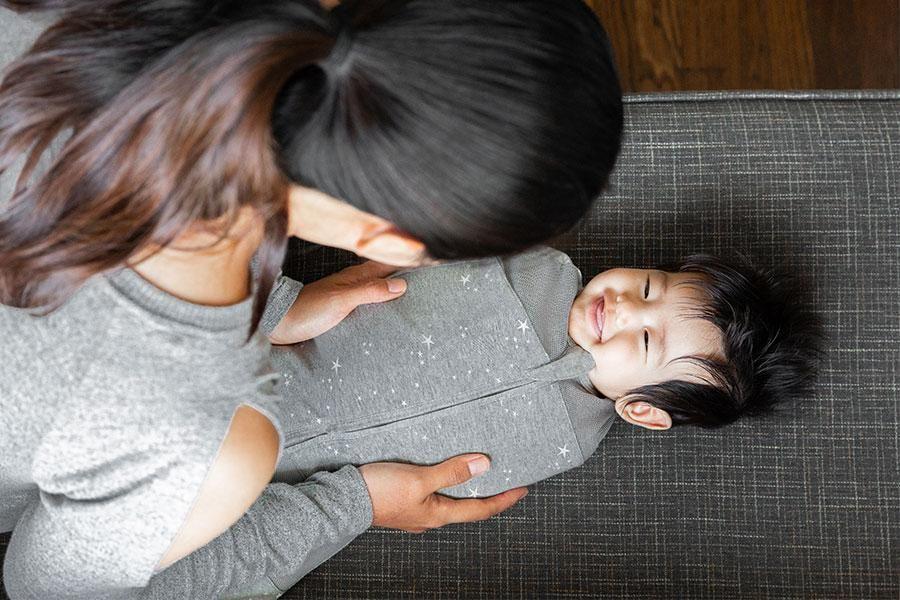BABY
Is Swaddling Safe?
When done correctly, safe, snug wrapping offers the following benefits.

Written by
Dr. Harvey Karp

SHARE THIS ARTICLE
PARENT PICKS
Bestsellers
BABY

Written by
Dr. Harvey Karp

SHARE THIS ARTICLE
Bestsellers
Four-month-old Reneja never woke up from her sleep. Her 24-year-old mother found her wedged between the wall and the soft mattress of the bed they shared in their Milwaukee home. Each year, over 200 parents in the UK go to greet their baby in the morning only to find them blue and lifeless. These infants die either from Sudden Infant Death Syndrome (SIDS) or from the increasingly common problem that befell Reneja, accidental suffocation. In 1992, medical professionals discovered a key cause of SIDS: stomach sleeping. Shortly thereafter, public health groups launched the Back to Sleep campaign. Back to Sleep reminds parents that the only safe sleeping position for babies is on the back. Over the past 20 years, we have also learned that parents can lower their baby’s cot death risk by avoiding smoking (during pregnancy or in the home after the baby is born), overheating, and removing bulky, soft bedding from the baby’s bed.
Today, these life saving recommendations are taught in hospitals, clinics and medical offices across the nation. And, we have cut SIDS deaths by over 50%. It is an enormous success and cause for celebration, but our work is far from done. The Lullaby Trust took a step in that direction by issuing a set of guidelines to prevent these deaths.
The recommendations include:
This is important advice. But, it overlooks one of the leading causes of unsafe sleep: infant irritability. Many babies hate sleeping on the back. Exhausted parents often spend hours trying to ease these criers back to sleep. Frustrated, some simply give up and lay their babies down on the stomach (tummy-down babies tend to fuss less and sleep more). Or, overcome with fatigue, they accidentally fall asleep — their baby nestled against their bodies — on an unsafe surface, like their bed, a recliner or couch. Either way, too many parents are tempted into a situation where the risk of SIDS and suffocation death increases significantly.
A key solution for reducing fussing — and thus promoting safe sleep — is swaddling. When done correctly swaddling a newborn for sleep offers the potential to:
And, the potential benefits of swaddling a newborn for sleep do not stop there. When combined with other calming techniques (like white noise, swinging motion and sucking) snug wrapping may reduce other serious problems triggered by infant crying/parental exhaustion, such as:
These problems place large emotional burdens on young families and significant economic burdens on communities. They result in lost productivity (due to worker exhaustion and absenteeism) and add well over $1 billion per year to health care costs. Many children’s health groups, such as the American Academy of Pediatrics and the Canadian Pediatric Society, recommend swaddling.
Not only can babies sleep swaddled, but swaddling is proven to promote restful and calm sleep. One common concern with swaddling during sleep is overheating. However, products (like our Sleepea Swaddle) that use breathable fabric, avoid this issue. But, like infant car seat use, we must teach correct swaddling so that it is done safely and effectively.
The keys to safe swaddling are:
If you are having trouble with swaddling technique, our Sleepea Swaddle will have your baby swaddled and safe in 5-seconds, top! It was specially designed with baby safety and parent sanity in mind.
Disclaimer: The information on our site is NOT medical advice for any specific person or condition. It is only meant as general information. If you have any medical questions and concerns about your child or yourself, please contact your health provider. Breastmilk is the best source of nutrition for babies. It is important that, in preparation for and during breastfeeding, mothers eat a healthy, balanced diet. Combined breast- and bottle-feeding in the first weeks of life may reduce the supply of a mother's breastmilk and reversing the decision not to breastfeed is difficult. If you do decide to use infant formula, you should follow instructions carefully.